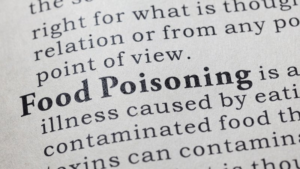Typically, food poisoning can be treated at home within a week, despite it being unpleasant and uncomfortable. However, food poisoning can be dangerous if the food which has been consumed is contaminated with a large number of unsafe bacteria, viruses or germs. Food poisoning can cause many unpleasant symptoms, such as vomiting and diarrhoea. If an individual becomes severely dehydrated as a result of food poisoning, they might need to go to hospital. Therefore knowing why food poisoning occurs and how to treat it is of the utmost importance.
How do you get food poisoning?
Food poisoning occurs when we consume food which has been contaminated with germs, such as bacteria and viruses.
Examples of bacteria which contaminate food:
- Salmonella
- Escherichia coli (E. coli)
- Listeria
Examples of viruses which contaminate food:
- Norovirus
- Hepatitis A and E
- Rotavirus
These types of bacteria and viruses can remain on food due to inadequate food hygiene and food safety practices. Poor food safety practices include:
- Failing to cook food to the core temperature of 75°C will mean that some bacteria will still be present in the food and not all of the bacteria will have been killed, and therefore those who consume the food could still become ill.
- Poor food hygiene can allow bacteria and germs from hands or clothes to transfer onto food and contaminate it.
- Leaving food out on the side for a long period of time allows bacteria to grow and multiply in the ideal temperature, therefore food which has been left of the side for more than 2 hours should be thrown away.
- If food is not reheated properly to the core temperature of 75°C, then bacteria will be able to remain and contaminate the food further.
- If food isn’t stored properly, bacteria will grow in the ideal warm conditions. Refrigerated foods should be kept between the temperature of 0°C and 5°C.

Symptoms of food poisoning
- Nausea
- Vomiting
- Cramps in the stomach
- Diarrhoea
- A temperature above 38°C
- Body aches
The above symptoms can be treated at home and should clear up after a week. When treating food poisoning at home, ensure that you get lots of rest, stay hydrated with plenty of water and eat small amounts of bland food which won’t irritate the stomach.
How to know if the food poisoning is dangerous
If your symptoms don’t clear up within a week or become very severe, this could be a sign that your food poisoning is serious.
Seek urgent medical attention if an individual is:
- Vomiting repeatedly
- Cannot keep a small amount of liquid in the body
- They are showing key signs of serious dehydration, such as confusion, a rapid heartbeat and inability to pass much urine.
Ms Rawnsley, a woman from Hertfordshire, sadly passed away after consuming a few mouthfuls of chicken which was contaminated with E-coli during a holiday in Corfu. Ms Rawnsley went to see a doctor after vomiting seriously in the aftermath of consuming the food, and she was diagnosed with a serious case of gastroenteritis. Following no improvement in her symptoms, Ms Rawnsley was admitted to hospital and sadly died shortly after this due to severe and dangerous food poisoning. The contaminated chicken which Ms Rawnsley ate had resulted in an E-Coli infection.
Therefore, food poisoning can be deadly, and it is important to know how to deal with dangerous episodes of food poisoning if they occur.


